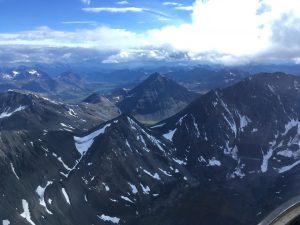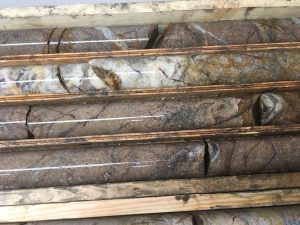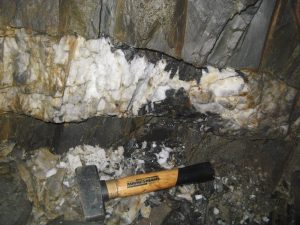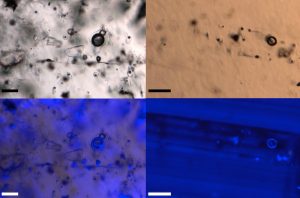Sources of tungsten in western North America

The aim of this study is to constrain the likely source(s) of tungsten in western North America (using the Sm-Nd and Rb-Sr radiogenic isotopes systems) and their pressure-temperature conditions of formation (using thermodynamic modelling). This study will provide new insights on the understanding of the geological processes that can lead to the formation of high grade/tonnage tungsten deposits and provide new targets for tungsten exploration in the Canadian Cordillera and in similar geologic settings. This project is being developed in collaboration with P.Geo Hendrik Falck (Northwest Territories Geological Survey), Drs. Hélène Legros, Kirsten Rasmussen, Yan Luo, Chiranjeeb Sarkar, Robert Creaser, D. Graham Pearson and Kurt Konhauser (University of Alberta), Dr. Erin Adlakha and Andree Roy-Garand (Saint Mary’s University), Dr. Leslie James Robbins (University of Regina), Dr. James M. Scott and Marshall C. Palmer (University of Otago), and Dr. Ken Hickey (University of British Columbia). Please feel free to contact me at elongo@ualberta.ca if you have any questions.
Spectral and geochemical characterization of the Silver Pond lithocap in the Lawyers Property, Northcentral British Colombia

The Lawyers Property is a well-preserved epithermal system within the historic Toodoggone District that hosts ~2.1 Moz Au-Ag and is currently being explored. The main objective of this study is to determine the spatial distribution of the broad hydrothermal system (low sulfidation, high sulfidation and potentially porphyry regions) with respect to the Silver Pond claim within the Lawyers district, as well as the potential structural/lithologic controls that have led to the distribution of claims and type of deposits within the region. This main objective is being pursued through determination of the spatial and paragenetic distribution of minerals in the Silver Pond prospect. This project is being pursued by Pascal Voegeli in collaboration with Benchmark Metals Inc., and Apex Geosciences.
Lithologic controls and alteration patterns associated with mineralization in the Yellowknife gold belt.

Gold deposits in the Yellowknife greenstone belt are thought to be the result of fluids of magmatic and/or metamorphic origin focusing through structural and geochemical traps. There are abundant structures crosscutting the Yellowknife greenstone belt. However, not all of them are mineralized. Therefore, additional factors such as spatial association with gold-rich plutons that may act as a source, structures that preferentially focus fluid flow, or a potential effect of geochemical composition of the host rock must play a major role in determining which structures are mineralized and which ones are not. This project aims to determine if the composition of the mafic volcanic flows in the Yellowknife greenstone belt are regionally a primary control on mineralizing shear zones and evaluate if there are discriminating factors in the alteration that help distinguish mineralized and unmineralized shear zones geochemically. The first field campaign took place in June 2019. The project is being developed by Lauren Langlois in collaboration with Hendrik Falck (NTGS), geologists from TerraX including Al Sexton and Matthew Steele-MacInnis (University of Alberta) and with support from Jordan Pearson.
Chemistry of fluids from mineralized and barren systems in the Tungsten Belt, Canada.

Tungsten mineralization is typically associated with reduced granititc magmas of crustal origin. While this type of magmatism is widespread, economic tungsten mineralization is highly localized with approximately 90% produced from only three countries worldwide. The Tungsten Belt, in the border between the Yukon and NWT hosts the only world-class tungsten deposits in western North America and also several occurrences of spatially-related weakly mineralized systems. Therefore this location provides a unique setting to compare whether there are significant differences in the processes that generate mineralized and unmineralized tungsten systems. This project focuses in the characterization of fluids at world-class deposits (Cantung and Mactung) and weakly mineralized systems (Lened and Rudi) through hand sample description, petrography, fluid inclusions thermometry, Raman spectroscopy and laser-ablation ICPMS analyses. The first sampling campaign for this project took place in July 2018. This project is being developed by Vanessa Elongo and Helene Legros in collaboration with Hendrik Falck (NWT Geological Survey), Erin Adlakha (Saint Mary’s University), Ehsan Salmabady and Ken Hickey (UBC).
Distal mineralogy of the Red Mountain porphyry-copper system, AZ, USA.

The mineralogy in the shallow portion of magmatic-hydrothermal systems commonly consists of clays. While mineral associations can vary systematically within these systems, clay mineral identification in hand sample or even through microscopic techniques can be ambiguous. Distribution and composition of clay minerals can potentially be used to evaluate the level of exposure or for vectoring towards heat sources in porphyries. Furthermore, quantifying the clay content of samples can be critical to processing ore. This project focuses on characterizing the distribution of clays in a porphyry with extensive vertical exposure (Red Mountain, AZ) through combination of hand sample description, microscopy, short wave infrared spectroscopy, and microprobe analyses. This project is being developed by Jordan Pearson and Cole Graham in collaboration with Benoit Rivard and Andrew Locock at University of Alberta, and Simone Runyon at University of Wyoming.
Evolution of fluid source at the Panasqueira tungsten vein deposit, Portugal.

Tungsten deposits are thought to form at depths comparatively higher than porphyry systems. Despite their depth of formation, there is evidence that meteoric fluids eventually percolate into these systems. The timing of meteoric fluid infiltration in these systems and the role that they may play in mineral precipitation remains unclear. This project focuses on determining how the source of fluids at the Panasqueira tungsten deposit evolves in relationship with the mineralogy of the system through combination of petrography, fluid inclusion thermometry and secondary ion mass spectroscopy (SIMS). This project is being developed by Karys Leonard-Fortune in collaboration with Richard Stern (University of Alberta); Marta Sosnicka, Marta Codeço and Phillip Weis (GFZ, Potsdam).
Role of organic ligands in the transport of REE

Rare earth elements are critical to the development of abundant emerging technologies. They are also carried in low concentrations (<ppm) in aqueous fluids under most geologic conditions and commonly used to interpret magmatic processes. However, REE mobilization of hundreds of ppm at relatively low temperatures (100-150°C) also occurs associated with hydrocarbon bearing brines. Since REE are used to track source rock (for oil as well as for ore deposits) this project focuses in investigating the potential role of hydrocarbons in REE transport of REE in aqueous solution at low temperatures. This project involves synthesis of hydrocarbon-bearing fluid inclusions in halite and Raman spectroscopy. This project is being developed in collaboration with Mohammed Bouabdellah and Oussama Zemri (University of Oujda, Morocco).
Salt precipitation in magmatic hydrothermal systems

Salt precipitation due to evaporation in sedimentary environments has been extensively studied. Analogously, boiling hydrothermal fluids at deeper levels in Earth’s upper crust also concentrate salt through preferential water loss. Theoretical modeling and indirect evidence suggests that during ascent, boiling fluids can become salt-saturated and precipitate halite. Salt, as one of the major components in geologic fluids, can affect rock porosity/permeability and thus fluid circulation; the mechanical properties of the rock; temporary storage of halogens (which are otherwise incompatible in most geologic materials); and metal transport and deposition at the temperature-pressure conditions of economic mineral deposit formation. This project evaluates when and where salt precipitation is expected to occur in these types of systems and how it relates to mineralization. The method used involves synthesis of fluid inclusions along PT paths representative of ascending hydrothermal fluids, comparison of natural and experimental systems, and thermodynamic evaluation of how this affects our current understanding of fluid behavior in magmatic-hydrothermal systems. This project is being developed by Maocheng Luo in collaboration with Matthew Steele-MacInnis (University of Alberta), Matthew Sublett and Robert Bodnar (Virginia Tech).
Properties of iron-rich fluids

Iron is one of the three main cations present in magmatic-hydrothermal fluids, but there is scarce data on the thermodynamic properties of iron bearing fluids at magmatic-hydrothermal pressure and temperatures. This project focuses on determining the thermodynamic properties of iron-bearing fluids using the synthetic fluid inclusion technique. This research has provided the first data on halite solubility at high temperatures in iron bearing fluids, as well as the vapor-saturated ice and halite liquidi, and has direct application to determining the fluid inclusion compositions from element ratios (LA-ICPMS) and microthermometric data.
